Journal list menu
Export Citations
Download PDFs
Editor's Choice
EDITORIALS
Extracutaneous manifestations and long-term sequelae of Stevens–Johnson syndrome/toxic epidermal necrolysis
- Page: 312
- First Published: 08 February 2015
COMMENTARIES
Aldara-induced skin inflammation in mice: close enough to psoriasis?
- Page: 313
- First Published: 08 February 2015
ORIGINAL ARTICLE, p 345
High-risk melanoma patients: can unnecessary naevi biopsies be avoided?
- Pages: 313-315
- First Published: 08 February 2015
ORIGINAL ARTICLE, p 365
γδ T-cell-rich benign cutaneous disorders: good or bad?
- Pages: 315-316
- First Published: 08 February 2015
ORIGINAL ARTICLE, p 372
Why should we care if onychomycosis is truly onychomycosis?
- Pages: 316-317
- First Published: 08 February 2015
ORIGINAL ARTICLE, p 380
Lifestyle changes can make a difference in psoriasis
- Pages: 317-318
- First Published: 08 February 2015
ORIGINAL ARTICLE, p 428
Vitiligo assessment methods – Vitiligo Area Scoring Index and Vitiligo European Task Force assessment
- Pages: 318-319
- First Published: 08 February 2015
ORIGINAL ARTICLE, p 437
Evidence and nuances of propranolol safety
- Pages: 319-320
- First Published: 08 February 2015
ORIGINAL ARTICLE, p 444
Filaggrin mutations in early- and late-onset atopic dermatitis
- Pages: 320-321
- First Published: 08 February 2015
ORIGINAL ARTICLE, p 455
Issues to address when investigating sunscreen use
- Pages: 321-322
- First Published: 08 February 2015
ORIGINAL ARTICLE, p 475
REVIEW ARTICLE
Blistering time as a parameter for the strength of dermoepidermal adhesion: a systematic review and meta-analysis
- Pages: 323-330
- First Published: 26 July 2014
What's already known about this topic?
- Structural and functional changes during skin ageing increase the risk for developing skin injuries.
- The artificial induction of suction blisters in humans is an established dermatological method.
What does this study add?
- Increased skin temperature and age are major predictors for reduced suction blistering times in healthy humans in comparison with suction pressure.
- Blistering time is an important and clinically relevant outcome parameter measuring the mechanical integrity of the dermoepidermal junction.
Original articles
CUTANEOUS BIOLOGY
Possible patterns of epidermal melanocyte disappearance in nonsegmental vitiligo: a clinicopathological study
- Pages: 331-336
- First Published: 05 June 2014
What's already known about this topic?
- Vitiliginous skin shows a complete loss of melanin pigment and a marked reduction or absence of melanocytes along the basal layer of melanocytes.
- Histopathological findings in vitiligo skin are discordant according to the type of depigmented lesions.
What does this study add?
- For the first time, two possible patterns of melanocyte disappearance that are correlated with histopathological findings and clinical features are proposed for nonsegmental vitiligo.
Lack of association of ALOX12 and ALOX15B polymorphisms with psoriasis despite altered urinary excretion of 12(S)-hydroxyeicosatetraenoic acid
- Pages: 337-344
- First Published: 28 June 2014
What's already known about this topic?
- Inflammatory and proliferative abnormalities of psoriatic lesions are accompanied by alterations in the 12- and 15-lipoxygenase pathways.
What does this study add?
- We investigated systemic production of 12(S)-hydroxyeicosatetraenoic acid (HETE) and its eicosanoid metabolites tetranor-12(S)-HETE, 12-oxo-eicosatetraenoic acid and 15(S)-HETE in a case–control study.
- Urinary excretion of lipoxygenases products was measured and candidate gene polymorphisms ascertained. No genetic association was found between psoriasis and the ALOX12 rs1126667 or ALOX15 rs11568070 variants.
- In patients with psoriasis, a significantly altered metabolism of 12(S)-HETE was found, manifested by its enhanced breakdown to tetranor-12(S)-HETE.
Aldara®-induced skin inflammation: studies of patients with psoriasis
- Pages: 345-353
- First Published: 01 July 2014
What's already known about this topic?
- The Aldara®-induced mouse model of psoriasis is now a frequently used model of psoriasis.
- The phenotype of the treated mouse skin shows many similarities with human psoriasis including the dependence of the cytokine pathways on the interleukin-23/17 axis.
What does this study add?
- The application of Aldara on human nonlesional psoriatic skin induced psoriasis-like skin inflammation, although typical psoriasis did not develop.
Topical application of delphinidin reduces psoriasiform lesions in the flaky skin mouse model by inducing epidermal differentiation and inhibiting inflammation
- Pages: 354-364
- First Published: 23 December 2014
What's already known about this topic?
- Psoriasis is a chronic inflammatory skin disease characterized by increased epidermal hyperproliferation, aberrant keratinocyte differentiation, impaired barrier function and infiltration of inflammatory cells.
What does this study add?
- Topical application of delphinidin, an anthocyanidin present in pigmented fruits and vegetables, reduced psoriasiform lesions and was associated with induction of epidermal differentiation, a reduction in keratinocyte proliferation, and modulation in the expression of tight junction proteins.
- Delphinidin treatment inhibited proinflammatory cytokines, infiltration of inflammatory macrophages and neutrophils, and increased the expression of activator protein-1 proteins.
CLINICAL AND LABORATORY INVESTIGATIONS
Integration of reflectance confocal microscopy in sequential dermoscopy follow-up improves melanoma detection accuracy
- Pages: 365-371
- First Published: 25 August 2014
What's already known about this topic?
- Short-term and long-term sequential digital dermoscopy is useful for monitoring atypical melanocytic lesions for diagnosing featureless melanoma.
- Reflectance confocal microscopy (RCM) provides a real-time noninvasive optical method and improves the diagnostic accuracy of melanoma, thus reducing unnecessary excisions.
What does this study add?
- Combining sequential dermoscopy imaging with RCM may help to reduce the burden of unnecessary excisions of lesions (false-positive) revealing minor dermoscopic changes at follow-up and RCM-negative score.
γδ T-cell-rich variants of pityriasis lichenoides and lymphomatoid papulosis: benign cutaneous disorders to be distinguished from aggressive cutaneous γδ T-cell lymphomas
- Pages: 372-379
- First Published: 21 August 2014
What's already known about this topic?
- Most lymphoid-rich inflammatory skin conditions are composed of T cells expressing αβ T-cell receptors (TCRs) and, in general, TCR γδ T-cell infiltrates of the skin are associated with aggressive cutaneous lymphomas.
What does this study add?
- Regardless of the presence or absence of lymphoid atypia, a subset of γδ T-cell-rich cutaneous lymphoid infiltrates are self-limited and indolent. Pityriasis lichenoides and lymphomatoid papulosis may present as a predominant γδ T-cell infiltrate.
When is onychomycosis onychomycosis? A cross-sectional study of fungi in normal-appearing nails
- Pages: 380-383
- First Published: 05 September 2014
What's already known about this topic?
- Fungi are present in onycholytic nails and in normal-appearing nails of individuals with dermatophytosis of other bodily sites.
What does this study add?
- Fungal organisms were found in the normal-appearing nails and feet of individuals without evidence of clinical pathology of the nails and feet.
- Although fungi may exist on the host in passive form, it is hypothesized that the presence of these organisms represents a preliminary stage of infection.
Immunofluorescence mapping in inherited epidermolysis bullosa: a study of 86 cases from India
- Pages: 384-391
- First Published: 28 July 2014
What's already known about this topic?
- Immunofluorescence mapping, an important diagnostic tool, helps in classifying epidermolysis bullosa (EB) and identifies the gene to be targeted for mutational analysis.
What does this study add?
- Specific immunofluorescence patterns were observed in cases of EB simplex and Kindler syndrome, which have not been described to date.
- There is greater discordance between clinical diagnosis and antigen mapping findings in the neonatal period.
- Performing antigen mapping during this period is critical for predicting prognosis and for genetic counselling.
Nano-TiO2 modulates the dermal sensitization potency of dinitrochlorobenzene after topical exposure
- Pages: 392-399
- First Published: 24 July 2014
What's already known about this topic?
- Nanoparticles can exert immunotoxic effects.
- TiO2 nanoparticles modulate dermal sensitization with dinitrochlorobenzene after subcutaneous injection (worst-case scenario).
What does this study add?
- TiO2 nanoparticles modulate chemical-induced dermal sensitization after topical exposure.
- Nanoparticles incorporated in a paint matrix have no immunomodulatory effects on dermal sensitization after topical exposure.
Stevens–Johnson syndrome and toxic epidermal necrolysis: follow-up of pulmonary function after remission
- Pages: 400-405
- First Published: 11 December 2014
What's already known about this topic?
- Specific bronchial epithelial detachment may occur during the acute phase of Stevens–Johnson syndrome/toxic epidermal necrolysis.
- Assessment of residual pulmonary dysfunction has not previously been described following remission.
What does this study add?
- Most of the patients were asymptomatic. Pulmonary function tests displayed a mild restrictive syndrome in five patients but no obstructive syndrome.
- Instead, alveolar diffusion was impaired, likely reflecting alveolar–capillary barrier damage, when high initial skin detachment was observed.
Most individuals with either segmental or non-segmental vitiligo display evidence of bilateral cochlear dysfunction
- Pages: 406-411
- First Published: 17 July 2014
What's already known about this topic?
- Melanocytes, the targeted cells in vitiligo skin, are also present in the inner ear and are critical for normal cochlear function.
- Clinical studies revealed that 12·5–18·9% of patients with vitiligo had sensorineural hearing loss.
- No studies have correlated the cochlear function and vitiligo subtype.
What does this study add?
- We compared cochlear function, measured by distortion product otoacoustic emissions, in patients with segmental vitiligo and nonsegmental vitiligo.
- Bilateral cochlear dysfunction is common in both types.
Abnormal sweating patterns associated with itching, burning and tingling of the skin indicate possible underlying small-fibre neuropathy
- Pages: 412-418
- First Published: 18 January 2015
What's already known about this topic?
- Peripheral neuropathies can cause itch and strange sensations in the skin, although reports are limited.
- Abnormal sweating is a finding in and marker for neuropathies, especially small-fibre neuropathy. Thermoregulatory sweat testing (TST) is an excellent tool to measure whole-body sweating.
- It is not known whether otherwise unexplained itch and strange sensations in the skin can result from peripheral neuropathy and, if so, how they can be diagnosed.
What does this study add?
- Results of TST were abnormal in the majority of patients with itching, burning, numbness and tingling sensations involving the skin, and the areas of anhidrosis on TST corresponded to their symptomatic areas.
- These results indicate that itching and strange sensations in the skin may be attributable to small-fibre neuropathy.
- Small-fibre neuropathy may underlie many cutaneous symptoms, and the neuropathy may be estimated using TST.
EPIDEMIOLOGY AND HEALTH SERVICES RESEARCH
Elevated odds of metabolic syndrome in psoriasis: a population-based study of age and sex differences
- Pages: 419-427
- First Published: 24 July 2014
What's already known about this topic?
- Evidence suggests an association between psoriasis and the metabolic syndrome.
- Population-based studies including mild-to-severe cases, age and sex variation, and information on confounding factors are scarce.
What does this study add?
- In this population-based study individuals reporting psoriasis displayed elevated prevalence of metabolic syndrome.
- The strongest association was present in young women, where those with psoriasis had up to fourfold increased odds of metabolic syndrome, independent of lifestyle risk factors.
- The results support a possible benefit from targeted screening for metabolic risk factors in all patients with psoriasis, irrespective of age and disease severity.
Impact of smoking on response to systemic treatment in patients with psoriasis: a retrospective case–control study
- Pages: 428-436
- First Published: 21 August 2014
What's already known about this topic?
- Smoking is a well-established risk factor for developing psoriasis and is associated with more severe disease.
- Smoking cessation does not appear to result in clinical improvement of psoriasis.
- Whether smoking in patients with psoriasis impacts response to systemic therapy is unknown.
What does this study add?
- In our retrospective psoriatic cohort smoking did not affect response to systemic treatments.
- A prospective study examining the complex relationship between smoking, psoriasis and response to systemic therapy is warranted.
Vitiligo Area Scoring Index and Vitiligo European Task Force assessment: reliable and responsive instruments to measure the degree of depigmentation in vitiligo
- Pages: 437-443
- First Published: 03 October 2014
What's already known about this topic?
- There are no standardized outcome measures to assess the degree of depigmentation in vitiligo.
- There is limited knowledge on the measurement properties of outcome measures in vitiligo.
What does this study add?
- The Vitiligo Area Scoring Index (VASI) and the Vitiligo European Task Force assessment (VETFa) are reliable and responsive instruments to assess the degree of depigmentation in patients with vitiligo.
- VASI and VETFa are potential measurement instruments to assess the degree of depigmentation in vitiligo research.
PAEDIATRIC DERMATOLOGY
Safety profile of a divided dose of propranolol for heart rate in children with infantile haemangioma during 16 weeks of treatment
- Pages: 444-449
- First Published: 12 July 2014
What's already known about this topic?
- Heart rates are thought to decrease during propranolol treatment for infantile haemangioma (IH).
What does this study add?
- Our study describes the careful and close monitoring of heart rate during 16 weeks of propranolol treatment in subjects with IH.
- We found that all heart rates were within the normal range and that a three-times-daily dosing regimen had no significant effects on heart rates in patients with IH.
- Our results reassure the safety of using propranolol at 2 mg kg−1 per day with respect to heart rates for up to 16 weeks of therapy.
Hypotrichosis associated with capillary malformation–arteriovenous malformation syndrome
- Pages: 450-454
- First Published: 24 July 2014
What's already known about this topic?
- Capillary malformation–arteriovenous malformation (CM-AVM) syndrome is characterized by multifocal small CMs and a risk for fast-flow malformations.
- The disease is caused by mutations in the RASA1 gene, implicated in vascular development.
What does this study add?
- Red punctate spots with pale halos are a frequent finding, as recently described.
- We report hypotrichosis associated with the CMs of CM-AVM syndrome, suggesting that RASA1 gene mutations could be involved in hair follicle proliferation and the cell cycle.
Filaggrin loss-of-function mutations are not associated with atopic dermatitis that develops in late childhood or adulthood
- Pages: 455-461
- First Published: 14 October 2014
What's already known about this topic?
- Filaggrin gene (FLG) loss-of-function mutations are a major risk factor for atopic dermatitis (AD).
- It is not clear whether FLG mutations are also important for late childhood or adult onset of AD, which develops in up to 20% of patients.
What does this study add?
- The development of AD during late childhood or adulthood is not associated with FLG loss-of-function mutations.
- Other susceptibility genes and/or other types of dysregulation are likely to be involved in the development of late-onset AD.
PHOTOBIOLOGY
Phototoxicity of narrowband ultraviolet (UV) B (311 nm) compared with broadband UVB in the photo hen's egg test
- Pages: 462-466
- First Published: 28 June 2014
What's already known about this topic?
- Broadband ultraviolet B (BB-UVB) has been further replaced by narrowband UVB 311 nm (NB-UVB), especially in the therapy of psoriasis, atopic eczema and vitiligo.
- Several studies have indicated a better therapeutic response for almost all indications compared with BB-UVB.
What does this study add?
- This study shows the phototoxic effects of NB-UVB in comparison with BB-UVB in an in vivo setting.
- Furthermore, it shows that the photo hen's egg test is a valid model for examining phototoxicity.
Combination of ablative fractional laser and daylight-mediated photodynamic therapy for actinic keratosis in organ transplant recipients – a randomized controlled trial
- Pages: 467-474
- First Published: 28 June 2014
What's already known about this topic?
- Daylight-mediated photodynamic therapy (dPDT) with methyl aminolaevulinate (MAL) significantly reduces pain intensities compared with conventional PDT for treatment of actinic keratoses (AK) in field-cancerized skin.
- Ablative fractional laser (AFL) resurfacing creates vertical channels that facilitate uptake of MAL and thereby increases the efficacy of PDT.
What does this study add?
- This study demonstrates that AFL pretreatment combined with dPDT has high tolerability and increased efficacy compared with conventional and dPDT for difficult-to-treat AK in organ transplant recipients.
Prevalence and trends of sunscreen use and sunburn among Norwegian women
- Pages: 475-483
- First Published: 03 October 2014
What's already known about this topic?
- Sunscreen is recommended to prevent sunburn and skin cancer.
What does this study add?
- The prevalence of sunscreen use is increasing among Norwegian women, but this increase has not been accompanied by a decrease in sunburn.
- Most Norwegian women use sunscreen, but less than one-third use sunscreen with the recommended sun protection factor (SPF).
- Using sunscreen with SPF ≥ 15 was not associated with lower risk of recent sunburn.
THERAPEUTICS
Secukinumab administration by pre-filled syringe: efficacy, safety and usability results from a randomized controlled trial in psoriasis (FEATURE)
- Pages: 484-493
- First Published: 16 August 2014
What's already known about this topic?
- Secukinumab is a fully human antibody targeting interleukin-17A.
What does this study add?
- Use of the secukinumab PFS was associated with high usability as determined by successful, hazard-free, subject-accepted self-injection.
- Self-administration of secukinumab via PFS allows the delivery of its clinical benefits with improved convenience in disease management.
- This phase 3 study in moderate-to-severe plaque psoriasis showed that secukinumab administration via pre-filled syringe (PFS) demonstrated significant clinical efficacy vs. placebo, with an acceptable safety profile.
Clindamycin phosphate 1·2%–benzoyl peroxide 3·0% fixed-dose combination gel has an effective and acceptable safety and tolerability profile for the treatment of acne vulgaris in Japanese patients: a phase III, multicentre, randomised, single-blinded, active-controlled, parallel-group study
- Pages: 494-503
- First Published: 12 July 2014
What's already known about this topic?
- Benzoyl peroxide (BPO) can cause a concentration- and frequency-dependent cutaneous irritation. A low concentration of BPO has been associated with improved tolerability.
- A topical fixed-dose combination gel of clindamycin phosphate 1·2%–BPO 3·0% is an effective treatment for acne in white people.
What does this study add?
- A gel combination of clindamycin phosphate 1·2% with BPO 3·0% is effective and maintains an acceptable safety and tolerability profile in Japanese patients with acne, who are perceived to have more sensitive skin than other ethnic groups.
Comparative efficacy of biological treatments for moderate-to-severe psoriasis: a network meta-analysis adjusting for cross-trial differences in reference arm response
- Pages: 504-512
- First Published: 07 October 2014
What's already known about this topic?
- Biologics currently indicated for psoriasis include adalimumab, etanercept, infliximab and ustekinumab.
- There are few randomized clinical trials that directly compare the efficacy of biological treatments for psoriasis.
- A number of cross-trial comparisons of biological treatment efficacy have been published and used by Health Technology Assessment authorities; however, these comparisons can be confounded by substantial cross-trial variation in reference arm response rates.
What does this study add?
- This is the first network meta-analysis of biological therapies for treatment of moderate-to-severe psoriasis that adjusts for reference arm responses.
- Results of this meta-analysis show that reference arm responses are an important confounder of biological treatment effects in psoriasis trials.
- A network meta-analysis adjusting for reference arm response provides a significantly better fit to clinical trial data than previously published approaches, and changes the comparative efficacy of available biologics for psoriasis.
CASE REPORTS
Cutaneous Richter syndrome: a better place to transform?
- Pages: 513-521
- First Published: 16 June 2014
What's already known about this topic?
- Richter syndrome (RS) denotes the development of high-grade lymphoma in patients with chronic lymphocytic leukaemia and is associated with a grave prognosis.
- Skin involvement is exceptionally rare with <20 cases reported in the literature.
What does this study add?
- We review the literature and present two further examples of RS arising in the skin.
- Cutaneous RS may have a more favourable prognosis than more common extracutaneous variants.
An unusual case of bilateral pyoderma gangrenosum with Achilles tendon rupture
- Pages: 522-526
- First Published: 12 July 2014
What's already known about this topic?
- Pyoderma gangrenosum (PG) is a rare, noninfectious, inflammatory ulcerating skin disorder that can affect deep muscle and tissue.
- The diagnosis is often difficult. Many case reports document patients initially being treated for cellulitis or having undergone surgical intervention, which has subsequently led to worsening of the disease (pathergy).
- PG rapidly responds to immunosuppression, and any surgical intervention should be postponed until the disease has been stabilized.
What does this study add?
- This is the first report of PG causing destruction of a tendon, highlighting its aggressive nature.
- We illustrate the importance of multidisciplinary team input in diagnosis and management, including the final reconstruction.
Founder mutation in dystonin-e underlying autosomal recessive epidermolysis bullosa simplex in Kuwait
- Pages: 527-531
- First Published: 24 July 2014
What's already known about this topic?
- The epidermal isoform of dystonin (DST-e), which encodes the 230-kDa bullous pemphigoid antigen (BP230), is a candidate gene for autosomal recessive epidermolysis bullosa simplex (EBS).
- Only two pedigrees with pathogenic mutations in DST-e have been reported, from Kuwait and Iran.
- The identified homozygous nonsense mutations led to a lack of BP230 protein at the dermoepidermal junction, poorly formed hemidesmosomal inner plaques and basal keratinocyte fragility.
What does this study add?
- We identified four new pedigrees from Kuwait, where seven individuals had recessive EBS due to the same homozygous nonsense mutation, c.3370C>T (p.Gln1124*), in DST-e.
- Haplotype analysis indicates that all affected individuals share a common ancestral mutant allele, also present in the previously reported Kuwaiti case.
- Clinically, individuals homozygous for this mutation have lifelong skin fragility. Most heterozygous carriers are asymptomatic.
- This condition may be more common in Kuwait than is currently appreciated.
RESEARCH LETTERS
Clinical features of Old World cutaneous leishmaniasis in elderly patients
- Pages: 532-533
- First Published: 25 September 2014
Influence of interleukin-6 gene polymorphisms in epicardial adipose tissue and coronary artery calcification in patients with psoriasis
- Pages: 534-536
- First Published: 17 July 2014
CORRESPONDENCE
Steroid treatment can improve the impaired quality of life of patients with acquired idiopathic generalized anhidrosis
- Pages: 537-538
- First Published: 24 July 2014
Intractable erosive lichen planus treated successfully with rituximab
- Pages: 538-540
- First Published: 17 December 2014
Human papillomavirus evaluation of vemurafenib-induced skin epithelial tumors: a case series
- Pages: 540-542
- First Published: 17 July 2014
Pure ocular mucous membrane pemphigoid reactive with both β4 integrin and the BP180 C-terminal domain
- Pages: 542-544
- First Published: 24 July 2014
The healing effect of over-the-counter wound healing agents applied under semiocclusive film dressing
- Pages: 544-546
- First Published: 24 July 2014




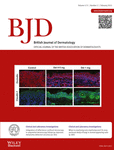

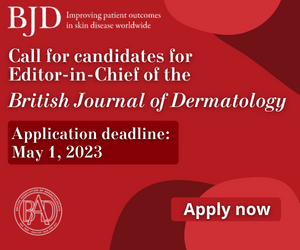
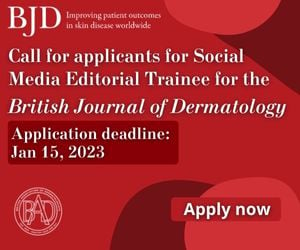

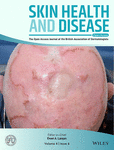
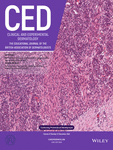
2690-442X.cover.png)